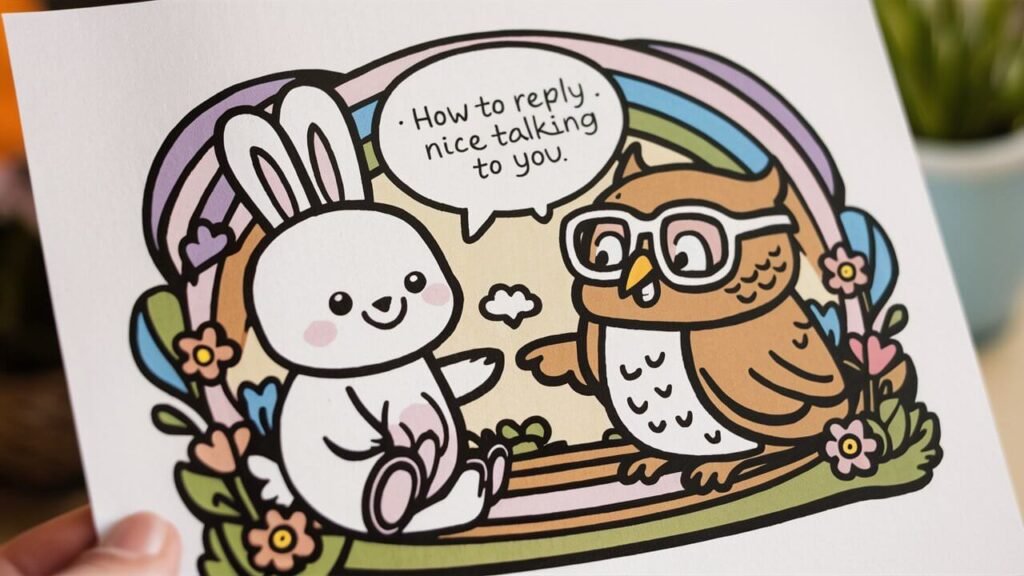
**Reply to “Nice Talking to You”**: “Nice talking to you too! Have a great day!”
**Introduction**: Effective communication strengthens relationships. A polite response shows appreciation for the interaction. It fosters positive connections. Expressing gratitude is crucial. It leaves a lasting impression. Always be courteous and considerate. Such responses are simple yet impactful. They reflect your positive attitude.
This makes future conversations more likely. People appreciate kindness and respect. These small gestures matter. They enhance mutual respect and understanding. Simple responses can build stronger connections. Always aim to leave a positive impact. Your words can brighten someone’s day. Being polite is always beneficial. It shows you value the conversation. This approach is always worth it.
Polite Responses
Someone says, “Nice talking to you.” You want to reply politely. Knowing the right words makes a big difference. This helps build stronger relationships.
Simple Thank You
A simple thank you works well. It shows respect and appreciation. Here are a few ways:
- Thank you!
- Thanks!
- Thank you, it was nice talking to you too.
Use these phrases to keep it short and sweet. They are easy to remember and use.
Expressing Gratitude
Expressing gratitude goes a step further. It shows you value the conversation. Here are some examples:
- I really enjoyed our conversation, thank you!
- Thank you, it was a pleasure talking to you.
- I appreciate your time, thank you!
These responses convey deeper appreciation. They make the other person feel valued.
Professional Responses
Professional responses can elevate your communication in various settings. Using professional language shows respect and builds trust. Learn how to reply “Nice talking to you” in a professional manner.
Formal Language
Use formal language to maintain professionalism. Here are some examples:
- “It was a pleasure speaking with you.”
- “I appreciate the insightful conversation.”
- “Thank you for your time and valuable input.”
These phrases reflect respect and attentiveness. They also convey gratitude for the interaction.
Acknowledging The Conversation
Acknowledge the conversation to show you were actively listening. This makes the other person feel valued. Consider these responses:
| Scenario | Response |
|---|---|
| After a business meeting | “I enjoyed our discussion on the project.” |
| After a networking event | “It was great learning about your work.” |
| After a client call | “Thank you for sharing your insights.” |
These responses show that you value the person’s contributions. They also reinforce the importance of the conversation.
Using these professional responses can leave a lasting positive impression. It fosters stronger professional relationships.
Context-specific Replies
Responding to “Nice talking to you” can vary based on the situation. Your reply should match the context. This can make your conversation more meaningful.
Business Settings
In a professional setting, your reply should be polite and formal. Here are some examples:
- “Likewise, have a great day ahead!”
- “The pleasure was mine, let’s stay in touch.”
- “Thank you, I look forward to our next meeting.”
| Situation | Reply |
|---|---|
| After a formal meeting | “It was enlightening, thank you.” |
| Networking event | “Great to connect, let’s collaborate soon.” |
Casual Settings
In casual settings, keep your reply friendly and relaxed. Here are some suggestions:
- “Same here, take care!”
- “It was fun chatting, see you around!”
- “Glad we talked, have a good one!”
- After a casual hangout: “Great time, let’s do this again.”
- Family gathering: “Always a pleasure, see you soon.”
Cultural Considerations
Understanding cultural considerations is key to effective communication. Saying “nice talking to you” can have different meanings in various cultures. Knowing these nuances helps in building respectful and meaningful relationships.
Cross-cultural Etiquette
Different cultures have unique ways of expressing politeness. In some cultures, direct communication is preferred. In others, indirect methods are more respectful. Using the right phrase shows cultural sensitivity.
Western cultures: Often appreciate direct and straightforward communication. Saying “nice talking to you” is usually seen as polite and friendly.
Asian cultures: May prefer more formal and humble ways of ending a conversation. Adding a bow or a formal gesture can enhance the message.
Middle Eastern cultures: May value extended greetings and farewells. Saying “nice talking to you” followed by blessings can be more appropriate.
| Culture | Preferred Phrase | Additional Gestures |
|---|---|---|
| Western | Nice talking to you | Smile, Handshake |
| Asian | Nice talking to you | Bow, Nod |
| Middle Eastern | Nice talking to you | Hand over heart, Blessings |
Adapting To Local Norms
Learning local norms can enhance your communication skills. Take time to observe and adapt to the local ways.
- Research: Read about the culture before engaging in conversations.
- Observe: Watch how locals interact and mimic their politeness.
- Ask: If unsure, ask for guidance on proper etiquette.
Adapting to local norms shows respect and builds stronger connections. Always be aware of the cultural context and be ready to adjust your expressions.
- Understand the cultural context.
- Use appropriate phrases and gestures.
- Be respectful and observant.
Communicating effectively across cultures requires awareness and adaptability. By considering cultural nuances, you can make your interactions more meaningful.
Digital Communication
Digital communication is key in today’s world. People often say, “Nice talking to you” online. Knowing how to reply properly is important.
Email Etiquette
Emails are formal. Your reply should be polite and professional.
- Start with a greeting.
- Thank the sender.
- Express your pleasure in the conversation.
- End with a sign-off.
Example:
Dear [Name],
Thank you for your email. It was nice talking to you as well.
Best regards,
[Your Name]
Messaging Apps
Messaging apps are casual. Keep your reply friendly and brief.
| App | Reply Example |
|---|---|
| Thanks! It was great chatting with you too! | |
| Messenger | Loved our chat! Talk soon! |
| Slack | Thanks! Enjoyed our conversation. |
Use emojis to add warmth to your message.
Common Mistakes
Ending a conversation can be tricky. People often make mistakes when replying with “Nice talking to you”. Here are some common mistakes to avoid.
Overly Casual Replies
Overly casual replies can make you seem uninterested. Use polite and thoughtful responses.
- Avoid: “Yeah, same here.”
- Better: “It was great talking to you!”
Keep a balance between casual and formal. Don’t sound too casual.
Lack Of Personalization
A generic reply can feel impersonal. Make your reply unique.
- Avoid: “Nice talking to you.”
- Better: “Nice talking to you, John!”
Using the person’s name adds a personal touch. It shows you care.
| Common Mistake | Better Option |
|---|---|
| Too Casual | “It was lovely talking to you!” |
| No Personalization | “Nice talking to you, John!” |
Be sure to avoid these mistakes. Your replies will be more engaging and memorable.
Frequently Asked Questions
How Do You Say It Was Nice Talking With You?
“It was nice talking with you” can be said as “Great chatting with you” or “Enjoyed our conversation”. Both are friendly and casual.
How To Reply When Someone Says They Like Talking To You?
Thank you! I enjoy our conversations too. It’s always great talking to you.
How Do You Respond When Someone Says Nice?
Thank you! I appreciate it.
How To Respond Nice Meeting You?
Respond with “Nice meeting you too,” or “It was great meeting you. ” You can also say, “Pleasure meeting you. “
Conclusion
Responding with “Nice talking to you” can leave a positive impact. Choose your words wisely to reflect genuine interest. Practice makes perfect, so keep refining your responses. Remember, a thoughtful reply strengthens connections and fosters better communication. Apply these tips and enhance your conversational skills effortlessly.

